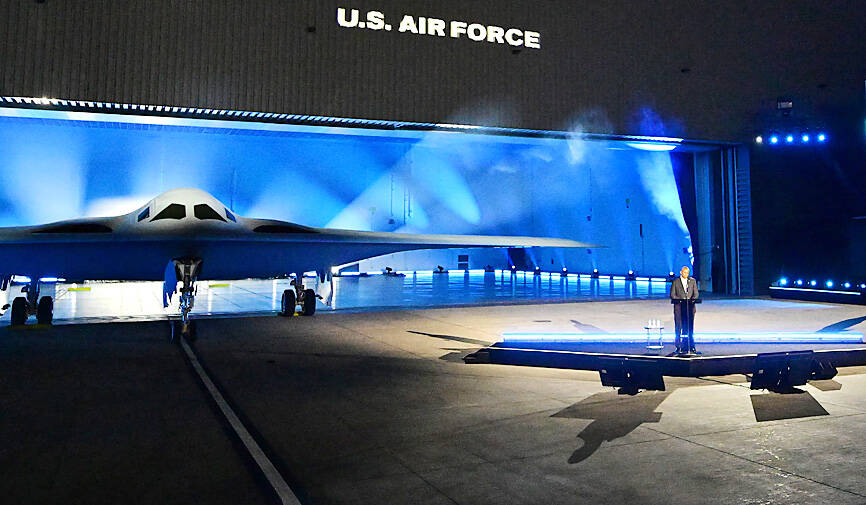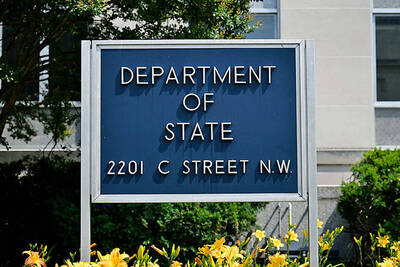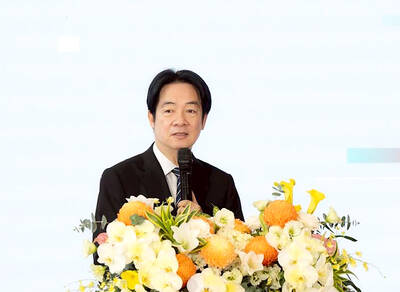The US is at a pivotal point with China and needs military strength to ensure that US values, not Beijing’s, set global norms in the 21st century, US Secretary of Defense Lloyd Austin said on Saturday.
Austin’s speech at the Reagan National Defense Forum capped a week in which the Pentagon was squarely focused on China’s rise and what that might mean for the US’ position in the world.
On Monday last week, it released an annual China security report that warned Beijing would likely have 1,500 nuclear warheads by 2035, with no clarity on how China would seek to use them.

Photo: AFP
On Friday in a dramatic nighttime rollout, Austin was on hand as the public got its first glimpse of the military’s newest, highly classified nuclear stealth bomber, the B-21 Raider, which is being designed to best the quickly growing cyber, space and nuclear capabilities of Beijing.
China “is the only country with both the will and, increasingly, the power to reshape its region and the international order to suit its authoritarian preferences,” Austin said on Saturday. “So let me be clear: We will not let that happen.”
The Pentagon is also concerned about Russia and remains committed to arming Ukraine, while avoiding escalating that conflict into a US war with Moscow, he said at the forum, held at the Ronald Reagan Presidential Library.
“We will not be dragged into Putin’s war,” Austin said.
“These next few years will set the terms of our competition with the People’s Republic of China. They will shape the future of security in Europe,” Austin said. “And they will determine whether our children and grandchildren inherit an open world of rules and rights — or whether they face emboldened autocrats who seek to dominate by force and fear.”
Still, between the two nuclear power threats, China remains the greater risk, Austin said.
To meet that rise, “we’re aligning our budget as never before to the China challenge,” Austin said. “In our imperfect world, deterrence does come through strength.”
The bomber is part of a major nuclear triad overhaul underway that the US Congressional Budget Office (CBO) has estimated would cost US$1.2 trillion through 2046.
It includes the Raider serving as the backbone of the future air leg of the triad, but it also requires modernizing the nation’s silo-launched nuclear intercontinental ballistic missiles and its nuclear submarine fleet.
The US Department of Defense has the largest discretionary budget of all the federal agencies, and it might receive up to US$847 billion in next year’s budget if the US Congress passes the current funding bill before this legislative session ends.
Defense advocates say it is still not enough to modernize and keep up with China because much of that spending goes to military personnel.

MISINFORMATION: The generated content tends to adopt China’s official stance, such as ‘Taiwan is currently governed by the Chinese central government,’ the NSB said Five China-developed artificial intelligence (AI) language models exhibit cybersecurity risks and content biases, an inspection conducted by the National Security Bureau (NSB) showed. The five AI tools are: DeepSeek, Doubao (豆包), Yiyan (文心一言), Tongyi (通義千問) and Yuanbao (騰訊元寶), the bureau said, advising people to remain vigilant to protect personal data privacy and corporate business secrets. The NSB said it, in accordance with the National Intelligence Services Act (國家情報工作法), has reviewed international cybersecurity reports and intelligence, and coordinated with the Ministry of Justice Investigation Bureau and the National Police Agency’s Criminal Investigation Bureau to conduct an inspection of China-made AI language

BOOST IN CONFIDENCE: The sale sends a clear message of support for Taiwan and dispels rumors that US President Donald Trump ‘sold out’ the nation, an expert said The US government on Thursday announced a possible sale to Taiwan of fighter jet parts, which was estimated to cost about US$330 million, in a move that an expert said “sends a clear message of support for Taiwan” amid fears that Washington might be wavering in its attitude toward Taipei. It was the first announcement of an arms sale to Taiwan since US President Donald Trump returned to the White House earlier this year. The proposed package includes non-standard components, spare and repair parts, consumables and accessories, as well repair and return support for the F-16, C-130 and Indigenous Defense Fighter aircraft,

CHECKING BOUNDARIES: China wants to disrupt solidarity among democracies and test their red lines, but it is instead pushing nations to become more united, an expert said The US Department of State on Friday expressed deep concern over a Chinese public security agency’s investigation into Legislator Puma Shen (沈伯洋) for “secession.” “China’s actions threaten free speech and erode norms that have underpinned the cross-strait ‘status quo’ for decades,” a US Department of State spokesperson said. The Chongqing Municipal Public Security Bureau late last month listed Shen as “wanted” and launched an investigation into alleged “secession-related” criminal activities, including his founding of the Kuma Academy, a civil defense organization that prepares people for an invasion by China. The spokesperson said that the US was “deeply concerned” about the bureau investigating Shen

‘TROUBLEMAKER’: Most countries believe that it is China — rather than Taiwan — that is undermining regional peace and stability with its coercive tactics, the president said China should restrain itself and refrain from being a troublemaker that sabotages peace and stability in the Indo-Pacific region, President William Lai (賴清德) said yesterday. Lai made the remarks after China Coast Guard vessels sailed into disputed waters off the Senkaku Islands — known as the Diaoyutai Islands (釣魚台) in Taiwan — following a remark Japanese Prime Minister Sanae Takaichi made regarding Taiwan. Takaichi during a parliamentary session on Nov. 7 said that a “Taiwan contingency” involving a Chinese naval blockade could qualify as a “survival-threatening situation” for Japan, and trigger Tokyo’s deployment of its military for defense. Asked about the escalating tensions